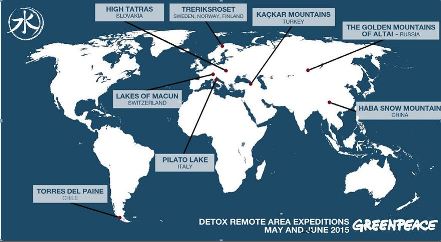Greenpeace called again on technical outdoor apparel brands to phase out use of poly-fluorinated chemicals (PFCs) by 2020 after releasing research showing traces of the persistent chemicals were found in snow and some water samples taken from remote mountain locations worldwide.
As part of the heavily footnoted report, “Footprints in the snow – Hazardous PFCs in remote locations around the globe,” eight Greenpeace teams led expeditions in May and June to investigate remote mountain ranges and lakes on three continents. Snow and water samples were taken in Chile, China, Italy, three Nordic countries, Russia, Slovakia, Switzerland and Turkey, and analyzed for environmentally hazardous per- and poly-fluorinated chemicals (PFCs).
Samples were taken between elevations of 511 meters at Kiruna in Sweden to 4,053 meters on Haba Snow Mountain in China.
The highest concentrations were found in samples from the Alps (Switzerland), the High Tatras (Slovakia) and the Apennines (Italy). The levels found are comparable to other studies that analyzed surface snow in the Tibetan mountains and Antarctica.

The outdoor industry uses PFCs to make products waterproof and dirt-repellent.
Once released into the environment, PFCs are broken down only very slowly. They remain in the environment for many years and are dispersed across the entire planet. Some PFCs cause harm to reproduction, promote the growth of tumors and affect the hormone system.
Most of the samples also contained so-called short-chain PFCs – increasingly used by outdoor brands instead of long-chain PFCs.
“As this report demonstrates, volatile PFCs such as the ones currently used by outdoor brands are being transported and deposited even in remote mountainous regions around the world,” Greepeace said.
”It is ironic to think that companies who depend on nature for their business willingly release dangerous chemicals into the environment,” said Mirjam Kopp. “Outdoor companies must take leadership for a better environment by making a genuine and credible commitment to stop using hazardous chemicals. They need to set short-term deadlines for completely eliminating the entire group of PFCs in production processes.”
Greenpeace noted that its expedition teams used PFC-free clothing and that some major athletic brands that also produce outdoor clothing, such as Puma and Adidas, have already adopted ambitious elimination targets for PFCs. Some smaller outdoor companies, such as Fjällräven, Paramo, Pyua, Rotauf, and R'ADYS, already have entire collections of functional weatherproof clothing that are PFC-free.
Since the beginning of its Detox campaign in 2011, Greenpeace has been calling on the clothing industry to eliminate all haz- ardous chemicals from its supply chain by 2020. In the first two studies, Greenpeace found PFCs are widely used in outdoor apparel and shoes and that volatile PFCS can evaporate from these products into the air. In this new study, Greenpeace finds that these hazardous chemicals have left their mark in the most remote and pristine places on earth.














